
Home - Search - Browse - Alphabetic Index: 0- 1- 2- 3- 4- 5- 6- 7- 8- 9
A- B- C- D- E- F- G- H- I- J- K- L- M- N- O- P- Q- R- S- T- U- V- W- X- Y- Z
CIA's National Intelligence Estimate 11-1-67
Part of CIA National Intelligence Estimates

NIE 11-1-67 Cover
The only remaining redactions on the Cover Page are the code words believed to be related to SIGINT-sensitive material…believed to be 'Chess Ruff'. This was 'Copy Number 1' - given to President Lyndon Baines Johnson. |
Updated version of NIE 11-1-67, obtained by Peter Pesavento, with most earlier redactions removed.
The CIA's National Intelligence Estimate 11-1-67 was handed to President Johnson in March 1967. It shows that the decision makers not only knew about the Russian lunar program, but were quite up to date with the latest Soviet schedule estimates. While their program information was solid, their knowledge of the Soviet launch vehicles and spacecraft under development was less so. This annotated version contrasts the CIA's knowledge of the program with what we now know to be the situation on the Russian side in February 1967. This new version of the document, with many earlier redactions removed, was obtained by Peter Pesavento, who has generously provided it for inclusion on this site.
Photo Gallery
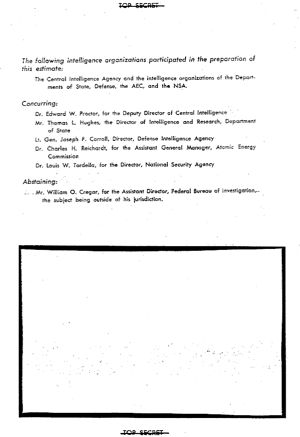 | NIE 11-1-67 Distrib
The US Intelligence Board -- consisting of representatives from the CIA, the Department of State, the Defense Intelligence Agency, the Atomic Energy Commission, the National Security Agency, and the Federal Bureau of Investigation reviewed the document before release. |
 | NIE 11-1-67 Contents
Note that developments in the Manned Space Program were of major concern on the eve of the beginning of piloted Apollo flights. This was clearly due to concern over who would win the moon race. Despite this, no NASA official was on the distribution list. |
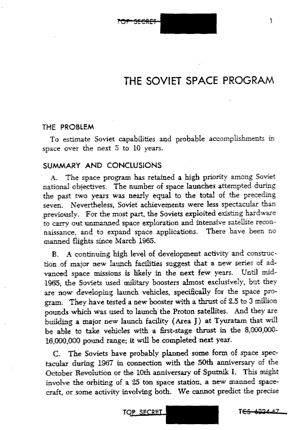 | NIE 11-1-67 Page 1
The fall-off of Soviet manned spaceflight activity after the last Voskhod flight is noted. The development of new launch vehicles (now known by their Russian designations, Proton and N1) are detected, primarily on evidence of photoreconnaissance of activities at the Tyuratam launch centre. It is correctly noted that a space spectacular was planned for September 1967 to commemorate the 50th Anniversary of the Russian Revolution (a Proton-launched space station is guessed at -- a manned circumlunar flight was actually planned). The CIA is more realistic than the Russian space management in concluding that any such near-term flights would have to be confined to 'near-earth space'. |
 | NIE 11-1-67 Page 2
The assessment is exactly correct in asserting that a major increase of effort was made in the 'past few years' but now had levelled off -- and that no decision on the long term Soviet space objectives had been made (Soviet space plans were always very fluid by US project management standards, and were dependent on the success of the N1 booster and American moves). The CIA has detected the primary payloads in development for the N1 -- the (MKBS) large space station and the (L3) manned lunar landing spacecraft. They correctly note that these two projects will be worked on sequentially, not in parallel, due to a lack of resources. And they are more realistic than the Soviets in concluding that a Russian lunar landing could only occur after Apollo -- and that a circumlunar flight could not occur until 1968. All in all, the US assessment shows more insight and realism than that of the Soviet space managers of the time. This perhaps indicates more experience in handling major aerospace development projects, while the Soviet military-industrial complex had not yet experienced the increased complexity of such large-scale projects. |
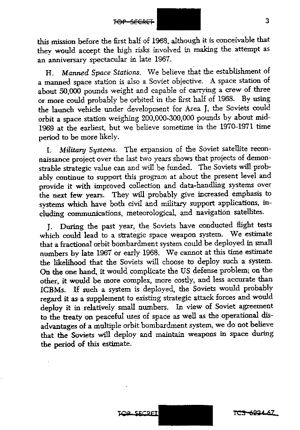 | NIE 11-1-67 Page 3
The program for development of the Almaz and MKBS space stations are correctly recognized, although both were years behind the schedule indicated. The programs for reconnaissance and application satellites are correctly enumerated. It is correctly estimated that the FOBS system will be of limited use and deployed in small numbers, and that space battle stations had been studied but rejected. |
 | NIE 11-1-67 Page 4
The fall-off in Soviet space systems development after 1965 (due to delays in development of the new generation of boosters and spacecraft) is noted. Plans for the cancelled Voskhod 3 mission were detected by the CIA. The capabilities of the new Soyuz spacecraft -- rendezvous, docking, 2-3 crew, re-entry from lunar distances -- are noted. |
 | NIE 11-1-67 Page 5
It was known that Leonov had difficulties in his EVA, but these were attributed to space sickness rather than suit ballooning and cabin air leakage. Redacted material for the Cosmos 110 flight may relate to SIGINT detection of telemetry from the dogs aboard or relate to HUMINT on long-duration ECS ground tests. Delays of the Soyuz program are correctly recognised as well as the reasons for the cancellation of Voskhod 3. |
 | NIE 11-1-67 Page 6
The tremendous failure rate of the unmanned lunar and planetary programs are discussed, as well as the space 'firsts' delivered by the few successes. It is known that the Russians have finally given up the first generation Molniya-launched Mars probes. Development of the Meteor and Molniya applications satellites is discussed. The redacted material evidently relates to SIGINT evidence that Cosmos 144 was a metsat. |
 | NIE 11-1-67 Page 7
The two types of reconsats (Zenit-2 and Zenit-4) and their masses and capabilities are correctly assessed, except that the estimated ground resolutions of the two models were estimated to be twice as good as was actually the case. The CIA was aware that the Zenits were carrying a supplementary ELINT payload. The redacted portion probably relates to the supporting evidence (HUMINT? SIGINT?) for the primary objectives of the Zenit program as listed. There seems to be no knowledge for plans for follow-on reconnaissance satellite development (TGR, Yantar, etc.) The space weapons discussion provides the curious designation of SS-X-6 for the SS-9-derived FOBS launcher (SS-6 was allocated to the R-7 ICBM, as indicated on the chart elsewhere in the report). Suborbital FOBS tests were monitored (the Tsiklon third stage reorienting to bring the warhead down in the Kamchatka recovery zone). The redacted portion probably relates to SIGINT-detected aspects of these tests. |
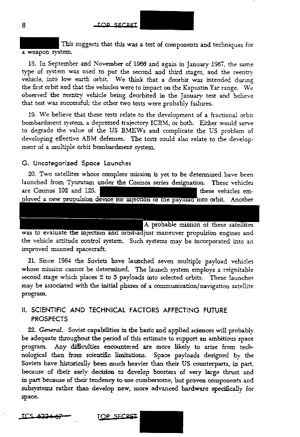 | NIE 11-1-67 Page 8
The CIA was evidently originally mystified by the purpose of the Cosmos 102 and Cosmos 125 launches (actually first tests -- without a reactor -- of the nuclear-powered RORSAT active radar naval reconnaissance satellites). There are two redactions, perhaps relating to HUMINT/SIGINT relating to the purpose of the satellites, with a final conclusion that they may have been tests of the propulsion system for the Soyuz spacecraft (completely incorrect). On the other hand, the early multiple-satellite launches are correctly assessed as the initial phase of communications and navigation satellite programs.. |
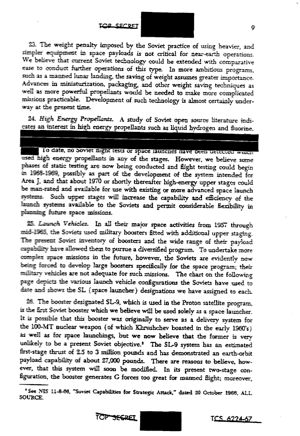 | NIE 11-1-67 Page 9
The CIA assessment is that the Soviets could get by with their heavy electronics equipment for earth orbit satellites, but they would have to develop miniaturized electronics for manned lunar missions (they tried with the heavier stuff anyway). Static testing of exotic propellant combinations was detected (possibly the redacted portion refers to observations of Glushko's test facility for fluorine-based propellants outside of Leningrad). The US believed Lox/LH2 upper stages for the N1 would be available by 1970 (in fact they were in design and low-priority development, but would not be fight-ready until the mid-1970's). The Proton is correctly identified as a dedicated space launch vehicle derived from an abandoned 100 MT ICBM design. It was noted that the original configuration was sub-optimal for a space launcher and that a new upper stage would be used for manned flights (in fact flown the week after the assessment was issued). |
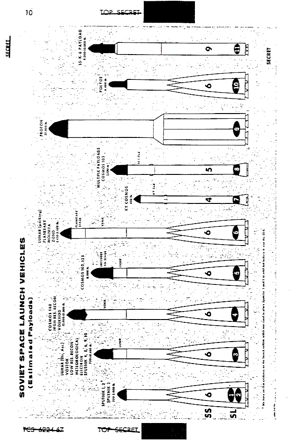 | NIE 11-1-67 Page 10
Chart comparing Soviet space launch vehicles. It is noteworthy that the CIA was fully aware of the detailed configuration of all of the flown boosters despite Soviet secrecy. This included such details as: the Proton strap-on units were not jettisonable, as on the R-7 (not realized by Western authors until the mid-1970's); the second stage vernier engine pods on the Kosmos and Tsiklon launch vehicles (deleted from missiles paraded in the 1960's and not known in the West until the 1980's). |
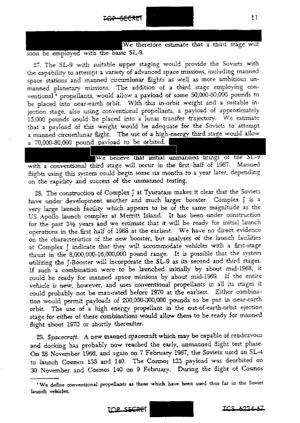 | NIE 11-1-67 Page 11
The payload capabilities of the 3- and 4-stage versions of the Proton are overestimated by 10%. It is correctly noted that the 4-stage version is to be used for manned circumlunar flights. Although the CIA expected a high energy upper stage for the Proton to be deployed in the near term, this did not happen (Glushko's RD-301/-302/-303 series began development in 1965 but was not flight-ready until 1977. By then the leadership decided the toxic propellants were too dangerous for flight use). The following discussion of near-term flight plans was exactly correct. The redacted material evidently relates to intelligence on the imminent flight of the 4-stage version of Proton (it came 3 days after the report was published). It was correctly determined that the test would occur '..in the first half of 1967..' and that manned flights would occur within six months ''...depending on the success...' of the new booster. This was indeed the plan, but the early Proton's high failure rate meant that it would not be man-rated until mid-1969... It is clear that the estimates in regard to the N1 booster were based on observation of the facilities construction at Tyuratam and it is explicitly stated that there was no '...direct evidence on characteristics...'. It is assessed that if the N1 used the Proton as its upper stages (Chelomei's competing UR-700 design) it could be ready for manned lunar flights by mid-1969, but if it was all-new (as was the case) this would not occur until 1970. There is an echo here of the contemporary Soviet debates between the UR-700 and N1 designs. The actual payload of the N1 was at the low end of the CIA's estimated range. Again, high energy upper stages were expected by 1970 (actual serious development of the modest Block Sr stage did not begin until May 1971 and was cancelled in 1974). |
 | NIE 11-1-67 Page 12
The characteristics of the new Soyuz spacecraft are again correctly assessed with Cosmos 133 and 140 identified as precursor missions and the expected first manned flight by mid-1967 (the disastrous Soyuz 1 mission, 40 days after the report). References to a larger and more capable manned spacecraft can only be understood if they are either incorrect or refer to the Almaz space station (in its original MOL-type design with a re-entry capsule). Limitations in orbital operations due to a lack of overseas tracking stations is discussed (in fact this would bedevil Soviet space operations throughout its history). |
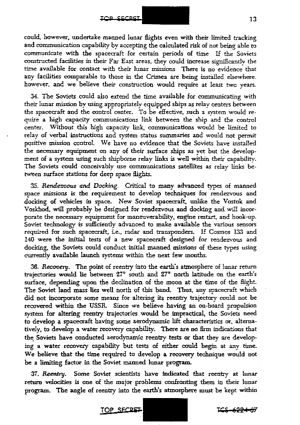 | NIE 11-1-67 Page 13
The CIA finds it hard to believe the Soviets will conduct manned deep-space missions with only the Crimean tracking facility. This would mean operations without 24 hour high-rate communications coverage, but they feel it possible the Russians might take this '…calculated risk…' (they did!!) It is noted that tracking ships were not adequate to the task without high-rate data links (but they were used in this way nevertheless). It is expected a docking of Soyuz spacecraft would take place in the 'next four months' (in fact this was the mission of the ill-fated Soyuz 1 just 40 days after the report was issued). The lack of any known water-recovery training operations indicated to the Americans that Soyuz would use body lift to manoeuvre from circumlunar distances to a landing on Soviet territory (as was the case). However the issue of water recovery of the Soyuz was a matter of continuing intense debate throughout the L1/L3 programs. |
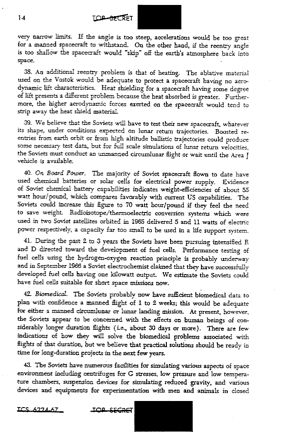 | NIE 11-1-67 Page 14
It is correctly noted that the Soviets will continue to rely mainly on chemical batteries and solar cells as space power sources. Fuel cells were indeed in development (for the L3 lunar program) but never actually flown. The continuing Soviet concern over the effects of long-duration spaceflight is detected but no evidence of their plans on how to address this are known (and were also not known to Soviet managers at the time...) |
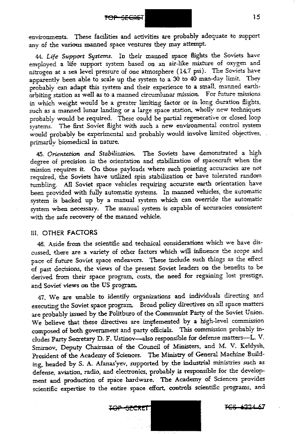 | NIE 11-1-67 Page 15
The technical aspects of the environmental control systems for the Vostok and Soyuz spacecraft are correctly identified. Absolutely correct identification of the key managers of the space program (Ustinov, Smirnov, Keldysh, Afanasyev) but the CIA claims no knowledge of lead engineers. The enormous Mishin/Chelomei schism, and the death of Korolev and its impact on the manned program, are not mentioned. |
 | NIE 11-1-67 Page 16
The CIA attempts to estimate the cost of the Soviet space program in terms of what it would cost the US to pursue a similar program. The numbers (increasing from $ 1 billion a year to $ 5.5 billion a year, then levelling off) amount to about half the US program of the time. The recently-signed Outer Space Treaty is mentioned and it is explained how the nuclear Fractional Orbital Bombing System does not violate it. |
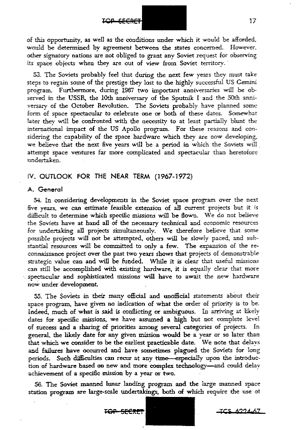 | NIE 11-1-67 Page 17
Again the expectation is repeated that a space spectacular will take place by October 1967 to regain prestige lost during the Soviet hiatus during the Gemini program. In assessing future mission over the next five years, it is correctly noted that the Soviets have too much on their plate in the manned space arena. It is assessed that 'useful missions' such as reconnaissance satellites will be fully funded (again true). And finally there is the spot-on prediction that '...delays and failures...(will)...plague the Soviets for long periods...(and)...could delay specific missions by a year or two...' (as occurred on the L1 circumlunar project). |
 | NIE 11-1-67 Page 18
The CIA has detected that both the MKBS large space station and L3 lunar lander projects are funded, but that the L3 will have first priority. It is noted that in 1965 (just as the Soviet manned lunar program began) the CIA had estimated that the Soviets would be unable to compete with Apollo in 1968-1969 (true in reality, but the Soviets certainly believed they could beat the Americans to the moon when the go-ahead was finally given!) It is stated that the lunar mission profile was not known. It was not believed that the N1 was capable of supporting a single-launch LOR profile (as turned out to be the case). It was expected that a two-launch EOR earth orbit rendezvous or even lunar surface rendezvous profile would be used, unless high energy upper stages were available at an early date. |
 | NIE 11-1-67 Page 19
It was assessed that the very earliest date for a Soviet manned lunar landing would be mid-1969, with 1970-1971 more likely. This was a very accurate prediction, considering the best/worst case status of the N1 project at that time. It was concluded that '...neither an interim or ultimate configuration for a space station...has been defined..' which was certainly true, with the Almaz / OPS / MKBS / OIS battles raging at the time in Russia. It is noted that an Almaz station could be launched as early as October 1967 and certainly by the first half of 1968. This may have been Chelomei's ever-optimistic predictions at the time, but in fact, Almaz would not have flown until 1970 at the earliest (even if the factory had not been diverted to Salyut station work). |
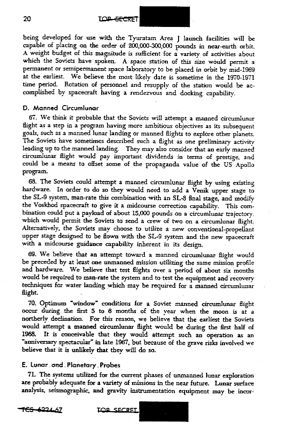 | NIE 11-1-67 Page 20
Again a very optimistic assessment is made that the large-size MKBS could fly as early as mid-1969, more likely 1970-1971. This is interesting information since the Soviets are still very secretive about the military OPS/MKBS station of the late 1960's. It is correctly assessed that the Soyuz will be the resupply craft. The following discussion of the Proton booster seems far off the mark. The actual propellant combinations used and planned in the booster and upper stages seem not to have been known. The use of the Voskhod capsule for return from circumlunar distances is proposed, but this purely ballistic design would subject any occupants to crushing g-loads (yet it seems that even if the CIA was still unaware of the precise configuration of the Voskhod capsule, they must surely have known that the Zenit/Vostok capsule was a purely ballistic design). It was believed that manned circumlunar flight could occur after six months of flight tests, and be accomplished by the October Revolution celebration, but this would entail 'grave risks' (as was the case)... |
 | NIE 11-1-67 Page 21
The limitations of R-7 derived launch vehicles for interplanetary probes are noted. It is anticipated that heavier Proton-launched probes will be sent to Venus as early as 1967 (actual first attempt to launch such probes came in attempts to reach Mars in 1969 - new generation Venus probes were not launched until 1975). It is noted that 14 ground stations for the Molniya communications satellite by November 1967. Direct-broadcast television from Molniya was expected by 1970 (actually not accomplished until Gals system was launched in 1990's). It was reported that 25 weather satellites were to be launched in 1968-1971 (actually 13) and that the system would be extended to earth resources work (actually work on this did not start until 1971 and first Meteor-Priroda was not launched until 1974). |
 | NIE 11-1-67 Page 22
It is expected that longer-duration versions of the low and high resolution photoreconnaissance/ELINT satellites (Zenit-2 and Zenit-4) will be developed (in fact the -2M and -4M versions were flown in 1968/1969). It was expected that versions with electronic image transmission, multiple return capsules, and data link via communications satellites would be developed (the multiple-capsule Yantar-2K was first flown in 1974, but the electronic imaging Yantar-4KS1 with data link via comsat did not start flying until 1982). A manoeuvrable reconsat was expected in the next few years (but the Zenit-6U did not start flying until 1976). It was believed development of new military applications (communications, weather, navigation) satellites also had high priority. The SS-X-6 FOBS system was to be operational by late 1967 or early 1968 (the system was actually declared operational on November 19, 1968). |
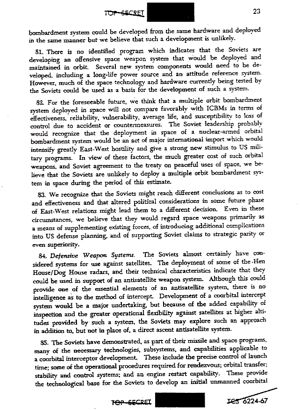 | NIE 11-1-67 Page 23
The CIA did not believe that the Soviet Union would deploy any offensive space weapons or an orbital interceptor (in fact flight tests of the IS interceptor would begin only seven months after the date of the report). |
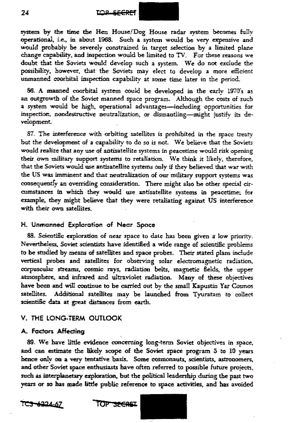 | NIE 11-1-67 Page 24
It was considered more likely that the ASAT weapon of choice would be a ground-based system using the Hen House and Dog House radar systems being built for the Soviet ABM system. Such a direct ascent ASAT was expected by 1968 (in fact there is little discussion in existing Soviet records of use of their ABM system in an ASAT role). The value of a co orbital satellite interceptor was considered minimal due to the limited plane change capability and the low altitudes it could reach (nevertheless such a system was deployed). It was considered likely if such a system was developed, it might be developed from the Soyuz manned spacecraft (an interesting observation in view of interceptor versions of the Soyuz considered in the early 1960's). |
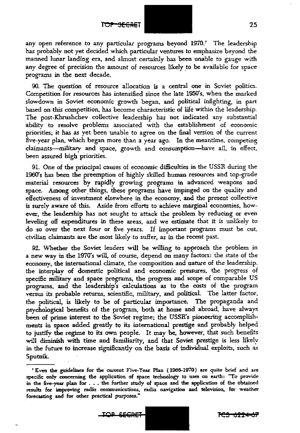 | NIE 11-1-67 Page 25
The CIA could not discern any firm plans for Soviet manned spaceflight beyond 1970. It was considered that the program would have to compete for scarce resources with higher-priority strategic missile programs. This was exactly the case and reflected the tenuous nature of Soviet government support of their space program. |
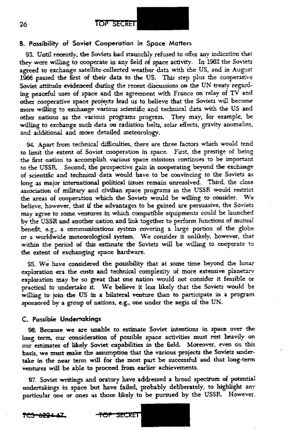 | NIE 11-1-67 Page 26
It was not expected that any US/USSR collaborative space measures could be expected until after the moon race was over. Even then, it was expected that any such ventures would be conducted under UN auspices (in fact détente and the need to adopt better technology and management practices after the moon race loss led the USSR to agree to the Apollo Soyuz Test Project in the early 1970's). |
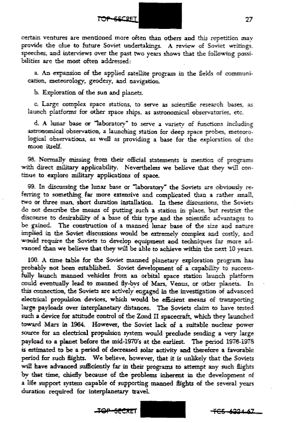 | NIE 11-1-67 Page 27
A lunar base or lab is correctly considered a long-term Soviet objective, but it is believed they will have no capability for such an enterprise for at least ten years. No manned Soviet interplanetary flights are considered possible until 1978 at the earliest due to the need to develop and prove an environmental control system for long-term flight. |
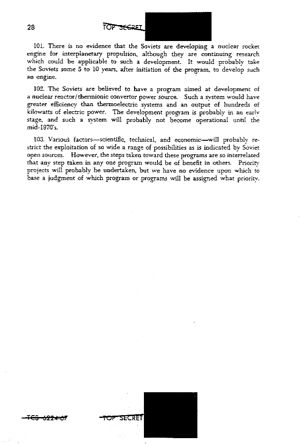 | NIE 11-1-67 Page 28
No nuclear thermal propulsion program had been detected within the Soviet Union. It was known that a space power reactor project was underway, but no deployment was expected until the mid-1970's (in fact the Russians had already flown prototypes of their RORSAT powered by chemical batteries, and the first nuclear-powered production version would fly in 1971). |
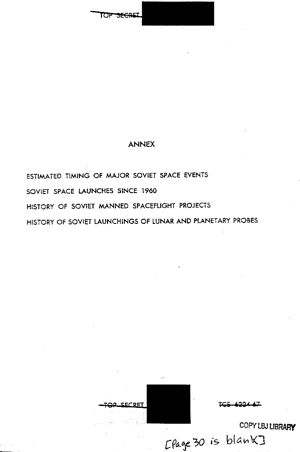 | NIE 11-1-67 Page 29
Table of Contents of Annexes - Page 30 was blank in original report. |
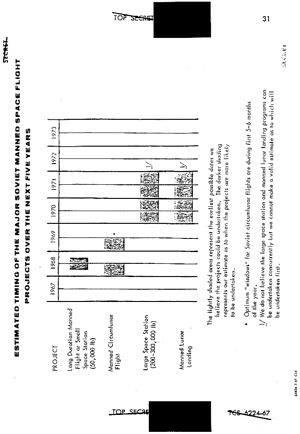 | NIE 11-1-67 Page 31
It is interesting to compare the CIA's predictions for manned spaceflight events with actuals:
| Project | CIA Predict. | Soviet Predict. in 67 | Actual | | Almaz station | Apr 68 | End 68 | Apr 73 (perhaps 71 if not delayed by Salyut project | | L1 circumlunar | Jan 68 | Jun 67 | Jan 69 (cancelled) | | MKBS station | Jan 70 | 1974? | Cancelled in 1974 with N1 booster | | L3 lunar landing | Jan 70 | Dec 68 | Cancelled in 1974 with N1 booster |
This page also considers a technical argument that L1 circumlunar flights could only be attempted in the first 5 to 6 months of each calendar year. However actual Soviet flights indicated no such constraint. |
 | NIE 11-1-67 Page 32
Major program summary chart. |
 | NIE 11-1-67 Page 33
Listing of known Soviet man-related missions. The CIA picked up the Vostok launch failures of 28 July and 22 December 1960. |
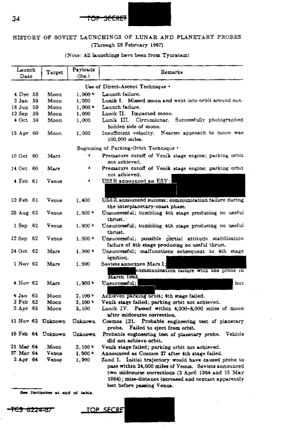 | NIE 11-1-67 Page 34
Listing of Planetary related missions. The CIA missed the launch failures of 23 September 1958, 11 October 1958, and 19 April 1960. All of these occurred prior to first stage jettison (T+120 seconds), perhaps indicating in the early days such failures could not be detected by US tracking stations in Turkey and listening posts. |
 | NIE 11-1-67 Page 35
Continued listing of planetary-related missions. The redacted portions seem to relate to SIGINT information concerning failures of the probes during their missions. |
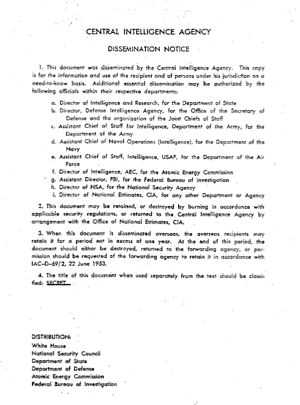 | NIE 11-1-67 Page 36
Distribution page. |
Back to top of page
Home - Search - Browse - Alphabetic Index: 0- 1- 2- 3- 4- 5- 6- 7- 8- 9
A- B- C- D- E- F- G- H- I- J- K- L- M- N- O- P- Q- R- S- T- U- V- W- X- Y- Z
© 1997-2019 Mark Wade - Contact
© / Conditions for Use






































